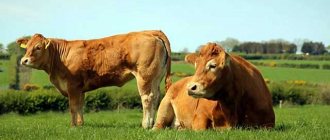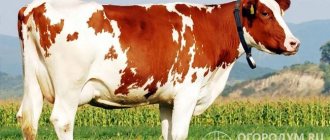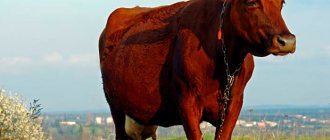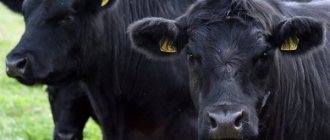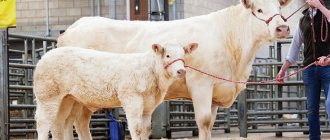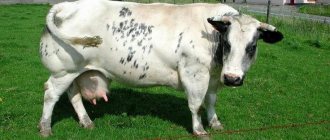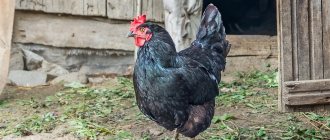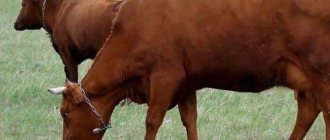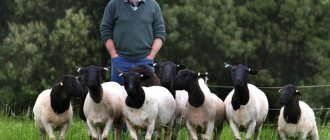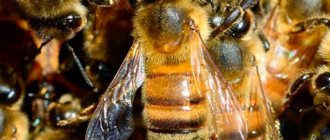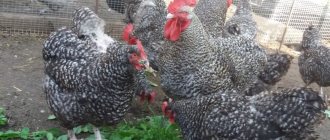History of origin
This breed cannot be called too old; it was bred in the USSR in the middle of the 20th century, to be more precise, in the 1930-1940s. In 1959, the breed was officially approved and this happened when it was finally possible to separate animals with a red color that was uncharacteristic of this breed.
By the end of the 70s, the number of such cattle in Russia numbered more than 10 million individuals. Today, black-and-white cows are the third most common cow in Russia. In this list, only red breeds and Simmental breeds are located in front of this breed.
It is impossible to single out any specific zone of distribution of the breed; it is popular literally everywhere. However, the largest number of black-and-white cows is concentrated in the Urals, Siberia, and the Far East. There are many of them in Ukraine and Belarus.
The Black and White breed was bred for the sole purpose of improving the productivity of existing breeds and increasing the endurance of animals. The last point is relevant, because many regions within Russia have a rather harsh climate.
Meat productivity
The weight of newborn calves is as follows:
- heifers are born weighing 35–36 kg;
- steers - 40–42 kg.
Calves have an excellent appetite, so their daily gain is up to 0.8 kg. Therefore, by the age of 1.5 years, these “youth” already have a mass of more than 400 kg. Individual individuals can weigh almost 500 kg.
Some bulls at this age can compete in weight with representatives of purely meat breeds of cattle.
Therefore, having good precocity and rapidly increasing body weight, young black-and-white bulls early turn into large animals, which at slaughter produce a large amount of lean beef.
Bulls of all types of mottled animals rarely weigh less than 850 kg (sometimes their weight approaches 1000 kg). Adult cows are also quite massive, their average weight ranges from 500–600 kg.
Slaughter yield of meat up to 60%.
Selection
The ancestors of this breed are considered to be the Dutch and Ostfries, who have been known since the 18th century. These breeds lived in the mild climate of Holland, were distinguished by high milk yields, but often suffered from cattle diseases. Among their disadvantages were a weak skeleton and poor immunity. It was these shortcomings that the breeders had to eliminate in the course of their work.
In order to get a good breed, characterized by vitality and endurance, local breeds (only the strongest and healthiest individuals) were crossed with Dutch breeds of a characteristic color. The first time, as one would expect, nothing worked, so several stages of selection work were required. Its first stages made it possible to breed only crosses, although quite successful ones. Then the task arose of increasing the productivity of these crossbreeds. The work was successful, and along with productivity, the animals’ immunity and appearance improved.
Work to improve this breed continues to this day. This is done in order to obtain not only excellent milk yield, but also optimal meat yield. Scientists are also working to improve the health of representatives of this breed.
It is expected that upon completion of the work, the animals will adapt as easily as possible and tolerate acclimatization in different regions of Russia, adapt to a variety of, sometimes changeable, climatic conditions.
Black and white bull
Characteristics
In appearance, the red-and-white breed is similar to the Holstein. Thanks to the breeds used by breeders to develop a new variety, the new cows turned out to be large in size with a voluminous udder. This is a dairy breed of animals, which is noticeable by its characteristic features.
Cows of this breed have the following advantages:
- increased milk productivity;
- adapt well to a new place;
- resistant to all kinds of infectious diseases;
- precocity of young animals;
- obtaining high quality products.
With all the advantages, cattle of this variety have certain disadvantages:
- they require high-quality feed;
- there is a possibility of defects in the structure of the udder (disproportionate location, excessively large or small nipples);
- the presence of little resistance to stressful situations - there is an opinion that animals of this breed are sensitive to changes in external factors.
But the shortcomings can be easily smoothed out if you strictly follow the recommendations for raising this type of animal.
On average, red-and-white cows live for 20-30 years. In total, an animal goes through three periods during its life. The cow, aged from 12 months to one and a half years, goes through a period of maturation. After this, for 15 years, milk and offspring can be obtained from the cow. This stage is called maturity. The third stage is called old age. It lasts for approximately 10 years. During this period, the cow no longer has any offspring, but if a calf is still born, it will be with some anomalies. In addition, at this stage the animal does not lactate.
Productivity in heifers is observed in the period from 2 to 4 years. A large farm usually keeps cows up to 15 years old. Moreover, the immune system of cows that are kept in production in order to obtain maximum material benefit is weaker in comparison with cattle living at home.
Characteristics
Like any other breed of cow, the black-and-white has some distinctive features, by which a specialist can easily identify a purebred animal. These signs include:
- The height at the withers of adult bulls is 135 cm, cows are slightly smaller - up to 125 cm. These are not the highest growth rates among cattle breeds, but a powerful physique gives the feeling of largeness.
- The average body length is 163 cm. A distinctive characteristic of the black-and-white breed is an elongated head with a wide forehead on a long neck. Bulls have a characteristic hump on their necks. The muscles on the neck are not very developed, but folds of skin are present.
- The horns are gray, their ends are slightly darker in shade.
- Females weigh about 760 kg, bulls grow up to 1000 kg.
- Calves are already quite large at birth, heifers are about 35 kg, bull calves are even larger - up to 40 kg. The breed is characterized by rapid weight gain; by the age of 1.5 years, young animals can weigh up to 500 kg.
- Heifers are precocious, reaching sexual maturity at 14-16 months. In order for a heifer to be considered ready for breeding, she must weigh at least 350 kg. Otherwise, pregnancy and calving may bring unforeseen complications and affect the future health of the female.
- The udder of black-and-white cows is large, with well-developed lobes, and it is cup-shaped. The nipples are long, symmetrically located, excellent for both manual and machine milking.
- High meat productivity is inherent in both cows and bulls, despite the fact that the breed is a dairy breed. The slaughter yield is never less than 60%.
- The head is black, but there is a white spot on the forehead. The predominant color is black, bright white spots can be located in any order.
- The legs are short, but powerful and stable.
Subspecies of the black-and-white breed:
- Animals distributed throughout the central region of Russia. They are practically no different from black-and-white ones either in weight or in milk yield. All products obtained from them are distinguished by high quality indicators.
- Cattle, common in the Urals, are characterized by a lean build. These animals do not look as massive as black-and-white ones, they are more graceful. The udder of females is well developed, milk yield remains at a fairly high level.
- Siberian cattle are the smallest of all varieties of the breed, but they are in no way inferior in weight. Such cows are distinguished by their versatility, that is, they produce both milk and meat.
Despite all their similarities, the differences are not too striking, so only a professional can distinguish these varieties. Milk productivity is maintained in any case.
Black and white
The Black-and-White breed was developed in Russia by crossing local cattle from various zones of the country with related breeds of Black-and-White cattle of Dutch origin.
Approved as a breed since July 1959. (Order of the USSR Ministry of Agriculture No. 148).
The direction of productivity is dairy. Distributed in all federal districts of Russia.
In terms of development, these are quite large animals: the live weight of black-and-white calves at birth is 30-35 kg, heifers at 18 months of age - 322 (in breeding farms 355-370 kg), cows - 488 (in breeding farms 524-541 kg ), bulls - 850-1070 kg. Adult animals are quite tall (height at the withers of cows is 128-135, bulls - 138-156 cm).
The exterior of the black and white breed is characteristic of dairy cattle. The color is predominantly black and motley. Animals of the black-and-white breed adapt well to climatic conditions and have good health. The udder of a black-and-white cow is large, cup-shaped, round in shape, and the belly is voluminous.
Young animals of the black-and-white breed have good growth energy. With intensive rearing, daily weight gain is 800–1000 g; by 15–16 months of age, the live weight of replacement young stock reaches 420–480 kg.
The average milk yield of cows is 3700–4200 kg; in breeding farm herds, the average milk yield of cows is 5500–6700 kg of milk with a fat content of 3.8–4.0% (fat content in milk ranges from 2.5 to 5.4%).
The best in the breed was the cow Rossiyanka 72, from which the milk yield for the fifth lactation was 18,086 kg of milk with a fat content of 4.15% ( breedings of the Chelyabinsk region).
In black-and-white cows, the protein content in milk is 3.2-3.4%, the udder index is 40-43%, the intensity of milk output is 1.68 kg/min.
Animals are quite precocious
: the average age at first calving is 31, in breeding farms and breeding breeders - 29-30 months.
The spread of the breed is facilitated by good acclimatization of animals in different zones of the country.
Purpose of breed selection
- simultaneous improvement of milk and meat productivity, since for the conditions of our country, animals of dual productivity with preferential development of milk production are preferable. A number of intra-breed types have been developed in the breed based on crossing with the related Holstein breed of American, Canadian and European selection: Leningrad, Lesnovsky, Moscow, Nepetsinsky, Barybinsky, Petrovsky, Ural, Irmensky, Zarya, which have high milk productivity.
The source of increasing the milk productivity of cattle is the widespread use of semen from high-value improver bulls and their descendants. This is facilitated by the widespread use of artificial insemination of animals and the use of embryo transplantation, which allows large-scale selection.
Association
for the improvement of black-and-white and Ayrshire cattle is located in St. Petersburg.
Productivity
Although the breed belongs to the dairy sector, bull calves are quite successfully fattened for meat. Thus, from this breed you get:
- Milk. Even under not very favorable conditions, cows’ milk yield is never less than 3000 liters per year. With good quality nutrition and care, they produce up to 8000 liters. Fat content is standard and is 3.7%. The highest milk yield is Siberian cattle, and the milk from these cows has a higher fat content. 4%. The lowest yielding variety is the Ural variety.
- Meat. At approximately 14 months, bull calves are already sent to slaughter; by this time they weigh up to 500 kg. This makes keeping black and white cows profitable.
Popular species in Russia and their characteristics
Some of the cattle mentioned above are largely distributed on the territory of the Russian Federation. Below is a list of the main breeds of this type.
Black and white
This breed of cows appeared as a result of crossing Dutch cows with local animals. Thanks to selection, several separate varieties of the black-and-white breed have been developed, adapted to different environmental conditions.
The black-and-white variety can be recognized by the following characteristics:
- dense, proportional build, wide rear;
- thin and fairly long legs;
- thin and elastic skin;
- relatively small head with short horns, flexible long neck;
- black and white color or black color with white spots;
- The udder is medium in size, depending on the region, it can be cup-shaped or round in shape.
It is bred to a greater extent for the production of milk with an average fat content of up to 3.5-4% and a protein content of up to 3.2%. In a year, an individual can produce more than 5 tons of milk. The average weight of a heifer is 500 kg, a male is 750-800. Average slaughter yield ~ 60%.
Holstein
In appearance, Holstein cows can easily be confused with the black and white breed; both have a characteristic black and white color and a fairly dense build. In rare cases, Holstein cows may have a red-brown color.
Holsteins are known as a breed that gains weight well; the specific weight of one cow can in rare cases reach 1 ton, while the weight of a bull is 1200 kg. Calves at birth weigh from 35 to 50 kg, but in a year they can gain up to 800 kg.
Externally, Holstein cows have a short stature (up to 135-140 cm, bulls up to 160 cm), a moderately large build, a wide chest and a developed cup-shaped udder. The head is small, the muzzle is slightly elongated.
Holsteins are known as record holders for milk production in Russia. There are cases when one cow could produce up to 20 tons of milk in a year. The result, unfortunately, was not justified, since with the chosen feeding method, the quality and fat content of the milk dropped significantly.
The average productivity for one cow will be approximately 7500 liters per year, while the fat content remains at 3.8-4%.
Despite their good milk production, Holsteins are often raised for good beef. The slaughter yield is no more than 55%, but even the most elite breeds can envy the quality of meat.
Kholmogorskaya
One of the most common types of dairy cows in Russia. Almost every farmer is familiar with this variety. The breed is characterized by good resistance to adverse weather conditions, good milk yield and milk fat content.
The breed has a black and white color, well-developed muscles, a wide hindquarters and thin legs. The head is regular in shape, the neck is flexible, long, and the udder is very well developed and round in shape.
Adult cows reach 600 kg in weight, bulls - up to 1 ton. The average height is small - up to 130 cm. The average milk production per year is about 4 tons.
Red steppe
It was bred exclusively for breeding in the southern regions of the country with an arid climate and insufficient amount of fresh grass on pastures.
The average weight of a cow is from 550 to 650 kg, a bull - up to 800 kg. The growth is small - up to 140 cm. Milk productivity indicators are quite impressive - up to 6 tons per year, and in rare cases (with good food and care) - up to 10 tons. The amount of fat is optimal and fluctuates around 3.5-4%.
Kostromskaya
In the USSR, this breed began to be bred back in 1945; it was obtained by crossing the Schwyz and Yaroslavl breeds. It is distinguished by its gray, sometimes brown color and tightly built physique.
The weight of an individual heifer reaches 800 kg, a male – 1200 or more, height up to 1.5 meters. It can produce up to 6 tons of milk per year with a fat content of 3.8-4%. Cows of this breed are distinguished by easy calving, rapid growth and good adaptability to different weather conditions and types of feed. The species is considered one of the most common not only in Russia, but also in Belarus.
Yaroslavskaya
The variety is considered one of the best among domestic dairy breeds. It is distinguished by its characteristic black color with rare white spots, an elongated proportional body, a long neck with a small head.
It is distinguished by weak bones and lack of developed muscles, the skin is thin and elastic, the average weight of heifers is no more than 5 centners, bulls - up to 800 kg. Milk productivity is above average - about 6 tons per year, taking into account the total fat content of a good 4.5%.
Advantages and disadvantages
The black-and-white breed was originally bred in such a way as to completely eradicate all the shortcomings of its ancestors. It was quite possible to achieve this, so this breed has many advantages. These include:
- Good health and excellent immunity. This means that cows can be transported to other regions without problems, and they will quickly adapt to life there.
- The ability of young animals to quickly gain weight, and simply on a nutritious diet, without any vitamin supplements or concentrated feed.
- All products obtained from black-and-white cows are of excellent quality, and quite a lot of it comes out of one individual.
Of course, it cannot be said that the breed is completely devoid of shortcomings, because the work of breeders continues to this day. Today, the breed has the following disadvantages:
- Not too high milk yield and low fat content of milk. This deficiency is easily corrected with good nutrition and proper care.
- Small size and weight of animals.
- Demanding conditions: animals love warm rooms, cleanliness and a varied diet.
Yaroslavl cow
According to many livestock breeders, it is the best representative of the dairy sector. This beautiful black animal with a white muzzle and a black mask around the eyes reaches a weight of 500 kg. The meat yield from such a cow is small - 40-50%, but the milk yield is 2500-3500 kg. milk for the 1st period of lactation (with a further increase in this indicator), and its average fat content is 4.2%.
The Yaroslavl breed cow is not picky about food, adapts well to living conditions and boasts enviable health. It should be noted that these animals are sensitive to temperature changes and need shelter in the summer heat and winter frosts. Another weak point of the “Yaroslavka” is its tendency to dislocations and fractures, so the owner should make sure that the cow walks on a flat surface.
Content Features
In order for animals to develop well and produce good products, it is important to adhere to the following recommendations for their care:
- The premises for livestock of this breed must be free. Ideally, there should be about 20 m2 of space per cow.
- A warm, dry barn is important for this breed, even though they tolerate cold well. When placing a barn, it is advisable to ensure that the windows face east or south. These minimize the likelihood of drafts, and thereby reduce the incidence of disease among the livestock.
- Good indoor ventilation, especially in winter, is important. It is necessary to provide for the possibility of additional heating of the barn in case of severe frosts. For livestock of this breed in winter, the optimal indoor temperature is +5-+12 degrees.
- Regular cleaning of the barn is important; pathogenic microorganisms that serve as carriers of a variety of diseases quickly multiply in rotten, very dirty bedding.
- The cow should have access to drinking water that is not too cold. The size of the feeder should be such that it contains a portion of hay, no more. Otherwise, the cow simply spoils it. If tethered housing is used, the length of the tether should be such that it does not restrict the cow’s mobility too much.
- It is best to keep cows without a leash so that they can move freely around the premises. However, the tethered method of keeping is better in that it eliminates the likelihood of fights among animals. In addition, with the tethered method of housing, feed is consumed most economically. Lack of keeping on a leash - the cow receives little physical activity, which often leads to a deterioration in her health.
- Cows of this breed love warmth and fresh air. If the frosts are not too severe in winter, they should be walked in open paddocks. When walking, the animal likes to eat hay.
- The bedding is made of straw and sawdust, and is regularly replaced with fresh ones.
- The pasture for grazing must be chosen with care: if this is neglected, an epidemic of some disease may break out in the herd. Before the summer period, when the herd will graze most of the day, the cows are examined by a veterinarian and, if necessary, vaccinated.
Characteristics of the breed of black-and-white cows
The black-and-white breed of cows is a purebred type of livestock. It is very popular among farmers due to its high milk productivity. This is its main purpose. But improving the quality and quantity of dairy products is possible only with proper care of cows.
In addition, black-and-white cows produce a lot of milk; they are also characterized by the following advantages:
- good health;
- quick adaptation to new conditions;
- moderate precocity with the ability to build muscle mass, while nutrition may consist of feed with a minimal concentration of additives.
In the video there is a black-and-white breed of cows:
Productivity
The milk yield of the breed in question is influenced by the region in which they are bred. Milk fat content is 3.2-3.9%. The highest percentage is observed in animals that are raised in Siberia, Estonia and Ukraine.
When breeding cows, they can produce milk up to 6500 liters per year. The record amount of milk is 10,000 – 12,000 liters. Another breed of cows with a black-and-white color is raised for meat. After slaughter, meat products account for 50%.
How to care
Black-and-white cows require special attention when caring for them. Animals must be kept in a large, dry barn. Its area should be 20 m2. Windows and doors should face south or east. This will prevent drafts from occurring.
And here you can learn more about the existing characteristics of the Simmental breed of cows.
It will also be interesting to see what the Jersey breed of cows looks like in the video: //gidfermer.com/zhivotnye/korovy/dzhersejskaya-poroda-korov.html
The room must be regularly ventilated. In winter, the optimal temperature for cows is 6-12 degrees. Clean the barn and feed troughs regularly. Give animals fresh drink. In summer, change it every other day, and in winter - every day.
Video on how to care for an animal:
Must be kept clean at all times. To do this, clean them with brushes and rinse the udder. In summer, animals need to bathe, so it is recommended to take them to water bodies. Trim your hooves regularly. If the cow will be grazing on a tether, she must allow the cattle to move freely.
Nutrition
Those who keep a black-and-white cow should remember that due to their large size, these animals require adequate nutrition. Ruminant animals consume 20 centners of hay per year, as well as concentrated and juicy feed. The taste and quantity of milk will depend on the quality of the feed.
In winter, animals need to have a feeder installed indoors. Its dimensions should be such that it can accommodate one portion of hay. There should also be a container of water in the barn. Change the fluid every other day. If the barn is cold in winter, change the water every day.
Depending on the size and age of the cow, the amount of feed will vary. To ensure that animals do not experience a lack of nutrition, it is necessary to prepare 30 g of straw and hay, 55 quintals of succulent feed.
This is the main food for black-and-white. 1 liter of milk yield requires 100 g of feed. If the animal gives more milk, then the dosage of food can be increased. If there are young animals, then the food supply will be 15 quintals of rough and 9 quintals of juicy cows per individual. But what nutrition the Hereford beef breed of cows should have is described in detail here.
Cow breeding
Black-and-whites are bred to improve the constitution of cattle and increase productivity. Breeders use purebred individuals of the same line.
This will allow the best qualities to be passed on to newborn calves, including:
- improvement of reproduction;
- reduction of the area of young animals;
- strong immunity to diseases.
Breeders are engaged in crossing different lines, thereby improving the quality of some dairy animals.
Inbreeding (crossing closely related forms) is rarely used, because it reduces the viability of the young. But with its help you can improve certain hereditary qualities.
But this information will help you understand what a Krasnogorbatovskaya cow looks like and for what purposes they are raised.
Diet
The most important condition is that the diet of black-and-white cows must be carefully balanced. In the summer, this issue is not so acute, because animals get everything they need from lush meadow grass, which they absorb in the right quantity.
In order for the cow to receive all the necessary substances in winter, you need to stock up on feed. High-quality hay, succulent feed (corn silage, root vegetables) - all this must be present in the required quantity. Hay reserves are made on the basis that for every 100 kg of live weight of a cow, approximately 3.5 kg of hay is consumed per day.
As already mentioned, clean drinking water is an integral element of the diet; the amount of milk milked directly depends on its availability. In the summer, if there is a pond on the pasture, there is no need to give the cow additional water - the animal itself will drink as much liquid as it needs.
No mineral supplements are required, table salt is enough (5 g per 100 kg of weight). It is important to follow a daily routine and feed the animals at the same time. A chaotic feeding schedule quickly leads to a decrease in milk yield.
Important! Cows are fed three times a day. If these are high-yielding cows, then feeding occurs 4-5 times a day. First of all, the animals are fed concentrates, and then succulent and roughage.
This breed of cattle requires more feed than many other breeds. This is due to the fact that milk yield most directly depends on nutrition. Both underfeeding and overfeeding have a negative impact on the health of cows. The best option is when the diet is selected individually, based on the characteristics of each individual, but overload of the gastrointestinal tract is unacceptable.
If hay and straw are not of high quality, they should be given to animals with caution. They are poorly digestible, so it is advisable to grind and steam them. Root vegetables are also pre-chopped, and the potatoes are also boiled.
Hardware milking of a black-and-white cow
Content
Not only the health of the species, but also the quality and quantity of milk production depends on the conditions of detention.
Summer period
These cows definitely need to move at least 3-4 hours a day. In summer, animals graze on pastures. There they are saturated with green food and also receive ultraviolet light, which helps in the production of vitamin D. A lack of vitamin causes a disease such as rickets.
Room (barn)
Room length – from 2 meters; if the animal is tied with a chain, make sure that it does not restrict the movement of the breed. Cover the floor with a deep, up to 25 cm, layer of straw and peat, which will help avoid unpleasant odors due to waste from the species.
The trough with food is hung at a height of 60 cm from the floor. To make a feeder, it is better to use wood materials, as they will last longer. Make separate bowls for hay and roughage.
Milking
Cows of this breed are perfectly adapted to machine milking; their milk yield rate is 1.5 liters per minute. The udder must be protected from various injuries - bites and wounds, the presence of which can sharply reduce milk production. Before each milking, the udder is washed with warm soapy water, wounds and bites are lubricated with special products as they form. The milk must be milked completely, without leaving any residue. After milking, the udder is treated with chlorhexidine or another similar compound. This is necessary to obtain a protective film on the nipples; it prevents germs and dirt from getting inside. The milking schedule is standard - two or three times a day.
Important! In order to quickly and effectively increase milk production, females during lactation are given cabbage, root vegetables and fish oil, chalk and any other additives with a high calcium content. Black-and-white cows produce the highest milk yield after 3-4 calvings.
Main features of cattle
A specific feature of animals of this breed is coloring. Their skin is mottled in color, with black or black-gray and white spots. It is soft and rather short, the skin is thin and delicate, with characteristic wrinkles and folds, especially in the neck, legs, head and abdomen. In a healthy animal, the croup and back are at the same level. Protruding shoulder blades or drooping lower back indicate a violation of the cow's skeletal anatomy.
In addition, the following morphological characteristics are observed in motley breed cattle:
- the body is somewhat elongated;
- the head is narrow, the muzzle is elongated, the nostrils are wide;
- the chest is quite narrow, especially in females;
- The udder of cows is large, with pronounced milk veins;
- the horns are small, light beige or light gray in color, with darkening at the ends;
- the skin is elastic, light pink in color;
- legs are quite short and strong;
- the skeleton is large.
Animals of this breed have a strong, properly developed skeleton
The average black-and-white cow has the following physical parameters:
- height at withers about 135 cm;
- back diagonal is approximately 160 cm;
- the weight of the female varies from 530 to 650 kg;
- meat yield at slaughter is about 55%;
- the life expectancy of the animal is 18-20 years;
- milk flow rate during machine milking is about 1.4 kg per minute;
- milk yield averages 7.5-8 thousand kg per year;
- the proportion of proteins in milk is about 3.3%;
- the percentage of lipids in milk is 3.5-4%.
The height of motley bulls can be up to 165 cm at the withers
The weight of a newborn calf varies from 35 to 42 kg, the weight gain reaches 750 grams per day. It is possible to increase weight up to one kilogram per day if intensive fattening is carried out. This feeding scheme is usually used for raising bulls for slaughter. Animals gain weight quite quickly, due to which by the middle of the second year of life the animal’s weight reaches 430-450 kg.
One of the most important advantages of this breed is its rapid adaptation to changing climatic conditions. This makes it possible to breed black-and-white cattle in fairly remote northern areas. Cows are undemanding in nutrition; the basis of their diet, depending on their habitat, is fresh greens, silage or hay.
Black-and-white cows tolerate cold well
Young animals
Cows of this breed produce calves with fairly strong immunity and high weight: the average weight of a heifer reaches 38 kg, and a bull reaches 46 kg. The survival rate among young animals is about 98%. In rare cases or as a result of improper care, calves are affected by intestinal disorders and diseases or bacterial pneumonia.
Motley calves have good health and are less susceptible to infections and colds.
Since young animals quickly gain weight with intensive complementary feeding, the breeder needs a relatively short period of time to raise livestock for slaughter. This is especially true for bulls, whose weight increases by about 30 kg per month. Insemination of heifers can begin when the female reaches a weight of 330-340 kg, that is, at the age of 1.5-1.6 years.
Bulls
Bulls of this breed are distinguished by fairly large bones, and their muscle mass is approximately a thousand kilograms. The height of the male at the withers reaches 157-162 cm; the animals have a massive head with an elongated muzzle, a short and massive neck, pronounced skin folds on the sides and back.
The standard weight of a bull is about 920-940 kilograms
Calving
Despite the fact that these cows reach sexual maturity already at six months, this does not mean they are ready to mate and bear a calf. You should wait until the animal gains approximately 350 kg of weight, and this will happen at about 1.5 years of age.
In order for calving to proceed without complications, it is important to create the right conditions. This implies the presence of a dry and warm barn. The cow should be separated approximately 2 weeks before calving. She needs this time to get used to the room.
During contractions, the animal behaves restlessly. If everything goes well, then the amniotic sac bursts on its own at the right time. If not, then it is cut and the amniotic fluid is drained. Then the cow begins to labor and a calf is born. Labor does not always proceed at the pace required. To enhance labor, the cow is given amniotic fluid or even given an injection of oxytocin.
After a successful calving, the animal needs to drink about two buckets of water. Then, for another period, you need to carefully care for the cow, clean the stall and feed it intensively. It is important to ensure that the cow’s placenta passes; this happens 2-10 hours after calving. Under no circumstances should it linger inside, this is fraught with a serious inflammatory process.
It is equally important that the cow does not eat her own afterbirth, as this can lead to digestive pathologies. If this does happen, the animal is not fed for a day, given a laxative, given a salt solution to drink, and the very next day it is switched to light food.
In fact, after 3-4 weeks the cow is ready for mating again, but only if the individual is in good health.
It is advisable that the calf be suckled by the mother for the first 10 days. Thus, his immune system is strengthened. After this period, it can be separated and the cow intensively milked. During this period, strict udder hygiene is important, and you need to feed intensively.
Breeding
Black-and-White bull
Breeding Black-and-White cows is possible after the heifer reaches physiological maturity. It occurs at approximately 1.6-1.8 years. It should be noted that the mass of the cow must be at least 300-320 kg.
Otherwise, gestation and birth will be too much stress for the animal’s body, and calves will be born weak and sickly. The reproductive cycle of a cow lasts from 20 to 23 days.
If the female is not pregnant, then the state of hunting is repeated every month. During this period, the heifer moos protractedly, rubs her rump against the walls of the barn, and raises her tail. During a physical examination of the animal, swelling and hyperemia of the genital organs and discharge from them can be noted.
In winter, estrus lasts about 8-9 hours, in summer – about 10-11 hours. If insemination occurs artificially, it is recommended to carry it out twice: upon initial detection of estrus and 8-11 hours after. This will increase the likelihood of fertilization.
After insemination, it is recommended to take the animal to a pen or tie it up.
Gestational period
A heifer is considered pregnant if she does not go into heat 28-30 days after insemination. The gestation period of cattle ranges from 270 to 300 days, depending on the subspecies.
About one and a half to two months before giving birth, the heifer is started, that is, milking is stopped. This allows the animal to direct all nutrients to ensure the life of the fetus.
It should be noted that an animal with a milk yield of more than 4.5 liters must stop milking gradually, over 2-3 days, to avoid the development of mastitis.
At least 40 days before the expected date of birth, you need to stop milking the cow
A characteristic feature of a cow that is preparing for calving is timidity and nervousness. The animal behaves restlessly, moos, and moves its feet.
During this period, it is necessary to examine the cow: the muscles at the entrance to the vagina should be soft and relaxed, a small amount of clear mucus without a strong odor should be released from the genitals, and milk should be released from the nipples.
The cow needs to be prepared for birth: rinse the area under the tail with warm water, and then wash with a pale pink solution of potassium permanganate. In the pen where the animal will calve, it is necessary to lay clean bedding and a piece of burlap.
After birth, the calf needs to be examined. A healthy animal behaves quite actively and tries to stand up on its own. If the cow does not lick the calf, it is wiped with burlap, mucous clots are removed from the nose and mouth, and the umbilical cord is cut 12-14 cm from the abdomen.
Calves of this breed are distinguished by good health and high survival rate.
The period of raising calves can be divided into four characteristic stages:
- Breastfeeding stage. It continues from the moment the calf is born until it reaches four months of age.
- Post-milk stage. It is characterized by the introduction of additional nutrition into the animal’s diet and lasts from four to six months.
- Rapid growth stage. During this period, heifers and bulls quickly gain weight. This group includes individuals up to one year old.
- The final phase, which lasts until the animal reaches 1.5-1.8 years. Calves that have reached four months of age require additional complementary feeding.
Each of these periods is extremely important and requires special conditions for raising and feeding livestock. Post-milk calves are fed with additional feed, and those that have reached six months are completely transferred to adult food.
Hotel complications
Common complications include:
- Uterine prolapse. This happens as a result of strong attempts, as well as if the calf was squeezed out by hand. This requires the help of a veterinarian.
- Postpartum paresis is paralysis when the animal experiences severe muscle tension and loss of posture. You can’t do without a doctor in this case either.
- Hypocalcemia is a postpartum complication, the symptoms of which are also paralysis and fainting of the animal. This is due to the fact that the level of calcium in the blood sharply decreases.
Take a good look at the cow before you buy it.
Feeding
The basis of the animal's diet should be plant feed.
It is possible to ensure rapid weight gain and high milk yield if the livestock's nutrition is properly organized. Animals must receive high quality feed in quantities sufficient to satisfy their needs.
Based on their origin, the components of the cattle diet can be divided into five groups:
- food of plant origin;
- animal feed;
- chemically synthesized complementary foods;
- feed;
- multivitamin supplements.
The largest part of the diet of black-and-white cows consists of plant feed. In this type of nutrition, the following subgroups should also be distinguished: succulent feed: pasture, silage and root crops; coarse: chaff, hay, grass meal; concentrated: processed grains and grain feeds.
Various supplements of animal origin are included in the diet of cows in small quantities. This is due to the structure of the oral cavity of cattle.
All kinds of complementary foods, supplements with a high content of minerals and vitamins are used to feed young animals, sick animals or cows with a deficiency of certain nutrients.
Compound feed can be used as feeding
Use of combined feeds
Compound feeds are mostly used for feeding animals in northern regions or to provide a complete diet for livestock in the winter.
It is also possible to use combined complementary feeding to quickly fatten animals for slaughter.
The following types of feed are distinguished:
- complete, they are used as the main component of the animal diet;
- concentrates - they are necessary for individuals experiencing an acute lack of certain nutrients;
- balanced feeds, which are used to optimize the animal’s diet and include essential vitamins and minerals.
Excess concentrated feed can cause disruption of the gastrointestinal tract in animals.
Feed should be inspected regularly. Hay or grain should not contain rot or mold, have a strange smell or color.
It should be taken into account that feeding animals exclusively with concentrated feed is fraught with the development of dyspeptic symptoms in the animal: bloating, stool disorders, flatulence.
In addition, an excess of carbohydrates and fermentation of feed can lead to the appearance of dysbacteriosis and the onset of rotting. This condition is usually easily diagnosed: the animal behaves apathetically and lethargically, lies down, and refuses food.
The stomach of a sick cow is swollen and elastic; palpation can reveal accumulations of food in the intestines. In case of such a violation of the condition, the animal needs the help of a veterinarian.
The specialist will perform intestinal lavage and prescribe medications to normalize digestion. In some cases, it is impossible to eliminate the pathology; the cow must be slaughtered.
Therefore, when introducing compound feed into the diet of cattle, you should carefully calculate the portion of food given to the animal.
Buying a cow
If the owner has already decided on the breed of cattle and proceeds directly to choosing an animal, you need to know what points you need to pay attention to:
- Condition of coat, eyes, condition of teeth and gums, skin. If an animal is sick with something, weakened or exhausted, this will be indicated by external signs: ulcers on the skin, discharge, pathological coloring of the mucous membranes, rash.
- Udder condition. Its structure should be uniform, without hard formations, inflammation, cracks and wounds on the nipples. It is advisable to try how a given cow is milked. It is important to notice whether the milk comes out too hard.
- Animal appetite. Like any other living creature, a healthy cow always has an excellent appetite; they are able to eat everything, without much discernment. An animal that has no problems is constantly chewing something. Lack of appetite is another indication of possible problems.
- Whether there is pregnancy or not. What plays a role here is how early the heifer was inseminated. Both too early insemination and late insemination are undesirable. If a heifer gets pregnant early, she will stop developing and will not be very productive. If you delay mating for more than 2 years, the cow may not become pregnant at all.
- The condition of the skeleton, joints, muscles, hooves is another important point. Lameness of the animal is also unacceptable.
- Horns are an important indicator of a cow; they can even be used to determine the number of calvings (if you count the rings). If you add 2 to the resulting number, this will indicate the age of the animal.
Origin of the breed
Pied or black-and-white cows have a fairly wide habitat and are found in various countries. This breed was first bred in the Netherlands, after which motley cattle, thanks to their characteristics, quickly spread to other territories. The mottled cow, bred at the end of the 18th century, belonged to the pure dairy type and had low muscle mass and an asthenic constitution. Over the next two centuries, with the help of selective measures, it was possible to increase the live weight of animals, improve their immune system and strengthen their bones.
Today, measures are still being taken to optimize the ratio of meat and dairy productivity of animals. For this purpose, the strongest individuals with high milk yield and impeccable health are selected.
The history of the appearance of black-and-white cattle
In Russia, motley cows appeared after the import of cattle from Holland and Sweden and their hybridization with domestic animals. In modern agriculture of the country, black-and-white cows make up about 38% of the total percentage of cattle in the country. The largest population is observed in central Russia: in the Moscow, Vologda and Nizhny Novgorod regions.
In Russia, within the framework of modern agricultural selection, work is also underway to improve the breed. To improve the physical characteristics of cows, insemination of heifers with sperm from breeding bulls . In addition, to increase milk production, crossing motley cattle with individuals of the Holstein-Friesian breed is used.
Currently, selection work is underway to improve the breed.
Calves
At birth, calves of this breed weigh up to 40 kg. Daily weight gain is about 800-1000 g, which depends on the quality of food.
Immediately after birth, you need to clear the calf's airways and bring it to the cow so that she can lick it. This natural process stimulates the release of the placenta and promotes the onset of enhanced lactation. The calves get to their feet quickly. After half an hour they make their first attempts to get up. If he fails to do this, it means he lacks oxygen, since the airways are occupied by amniotic fluid. In order to help the cub, it is lowered upside down and held until all the water comes out.
A little later, the calf is allowed to approach the cow's udder; it should begin to suck colostrum. If it has not yet begun to be produced, then prepare a mixture of fresh milk from another cow, eggs, fish oil and salt. The calf is bottle fed.
A little later, when the cow's milk comes in, the calf switches to it. It takes about one week for colostrum to change into milk. Because of this, the product produced by the cow in the first week after calving is not used for food.
Approximately 10-14 days after calving, the calf is weaned from its mother for separate feeding. He is fed three times a day, salt, calcium, and vitamin supplements are added to his food. By the beginning of the third week of life, hay is gradually introduced into his diet.
Conditions of detention
The fat content and amount of milk depends on the temperature of the cow. At low living temperatures, the species produces fairly rich milk, but in small quantities. At high temperatures the opposite is true: there is a lot of milk, but it is not fat enough. Based on this, you need to find a “golden mean”.
First of all, eliminate drafts. Since the Kostroma breed of cows is not recommended to be kept in greenhouse conditions, turn on the heating in winter only during severe frosts. As a rule, the recommended temperature for keeping cows and bulls in winter is not lower than 10°C. For sleeping, provide the animals with a bed of hay.
The Kostroma cattle breed does not like heat. Therefore, take care of large windows when arranging your shed. They will be sources of light and will also allow fresh air to enter. In winter, LED lamps will be needed in the barn to provide additional light. Remember, you should not open windows in winter, as animals are afraid of drafts. Provide ventilation for air flow and saturation of the shed with oxygen.
Cleaning the barn
Place special bedding on the floor of the barn, which consists of a mixture of hay and peat. Change bedding as often as possible, as it absorbs animal waste and pollutes the environment. Try to clean the stool drainage ditch and wash the floor with water every 1-2 days. Disinfect the shed once a week using special products. Clean the ventilation every 30 days to prevent the accumulation of dust and germs. Check food and drink containers periodically and wash them if necessary.
Feeding in summer
In the summer, animals get their own food on green pastures. But cows also need to be fed. This is due to the fact that the grass contains many vitamins, but sometimes not enough protein and sugar, which are also necessary for the health of the species. One cow of the Kostroma breed eats about 25 kg of succulent and about 5 kg of feed per day.
Feeding in the cold months
In winter there are no green grasses, so the cow’s diet consists of vegetables and root crops, mixed feed, and silage. The feed is based on various grain crops, such as wheat, barley, oats. Additionally, mineral and vitamin supplements are added.
It is also useful to feed the Kostroma cow with ground vegetables and root vegetables. The most favorite and useful for the species:
- beet;
- zucchini;
- potato;
- carrot.
In addition, chalk and table salt are added to the food.
The transition from summer to winter diet should be gradual so that the animal’s intestinal microflora has time to adapt. To suppress pathogenic microflora, antibiotics are periodically added to animal feed.
Remember that the Kostroma cow quickly gets used to the schedule: sleep, eat, walk at the same time. Milk yield directly depends on this. Therefore, the correct regime, attentive attitude, and good housing conditions will have a beneficial effect on the productivity of the breed.
External data
External characteristics allow you to accurately determine the breed of the animal. The Black-and-White has a number of distinctive features that make it easy to distinguish it from the rest. The color of the animals is only black and motley. The skin is thin, gathering into small wrinkles in certain areas of the body. The wool feels soft and silky to the touch. It is thick enough to protect the cow from the cold. The shape of the head is elongated, the muzzle is elongated. The horns are light gray in color, darkening at the ends. The neck is of medium length with underdeveloped muscles.
Appearance of a black-and-white cow
The cow's body is strong with level withers. The belly is significant. The udder is cup-shaped with asymmetrical lobes. The rear nipples are close together. Legs are straight and strong. The tail is slightly raised.
A cow weighs from 470 to 550 kg. The weight of bulls is from 800 kg to 900 kg. The growth of the animal is rapid, and already at one and a half years the cow has a mass equal to half of its maximum weight. Height at withers from 130 to 140 cm
Breeding and general care rules
Keeping cattle includes a whole range of necessary measures: regular examination of the animal by a veterinarian, high-quality nutrition, milking, procurement of raw materials, cleaning of the premises in which the cows live. A significant drawback of animals is that they are very demanding in terms of living conditions.
The room where animals live must be spacious, warm and dry, the minimum area is 20 m². The doors and windows of the barn should face the east and south sides.
Black-and-white breed of cows grazing
In winter, good lighting and good ventilation should be provided. Optimum temperature +5-12 degrees. It is very important to clean the room properly. Proper arrangement of a barn includes:
- Availability of feeders. The volume of each should be such that it can accommodate a portion of hay.
- Container with water. It should always be full, the water should always be clean, so it is recommended to change it every other day.
Important! The leash should not hinder the movement of animals.
To prevent the development of diseases, the animal should regularly clean its coat using a brush, wash its udder, and trim its hooves. In summer, it is recommended to regularly carry out water treatments.
Nutrition
All cows have different feed needs. They depend on the size of the animal, the amount of milk produced, and the conditions of detention. The majority of the diet should be high-quality hay. For every 100 kg of animal weight there should be at least 3.5 kg of hay. To increase milk yield, the diet should be enriched with sleepy feeds, for example: potatoes, corn silage, turnips, and watermelon.
Breeding black and white cows
The purpose of cattle selection is to improve meat and dairy productivity and the constitution of animals. To do this, crossbreeding is carried out using the Dutch Holstein-Friesian breed. Selection work of the black-and-white breed is carried out using the method of purebred breeding of animals of the same line. Such animals generally stably pass on their breed qualities to their offspring, including health factors:
- reproductive abilities;
- mortality of calves due to paternal abnormalities;
- mortality of calves due to maternal abnormalities;
- resistance to mastitis;
- resistance to other diseases.
By mating with different lines, it is possible to improve the quality of animals from one line at the expense of the other. Very rarely and with great caution, farmers cross animals of close relatives (inbreeding) - to enhance any hereditary qualities. But inbreeding can reduce the viability of the resulting offspring.
Description of the breed
The black-and-white cow was bred recently - in the 1930s and 40s in the USSR, and was approved as a separate breed only in 1959. The ancestors turned out to be imported Dutch bulls, which were crossed with local cows.
At first, the first representatives were rather frail, with poor health and a fragile physique, however, despite these shortcomings, they had high milk production. After selection work, the animals became stronger, acquired more developed muscles, good immunity and excellent health.
Adult individuals of the black-and-white breed have the following exterior characteristics:
| Horns | gray in color, darker tips, small in size |
| Head | oblong, with elongated muzzle |
| Neck | length - average. Covered with folds, muscularity is not developed |
| Breast | medium width with a depth of about 70–75 cm |
| Udder | large, voluminous. It is shaped like a bowl, with unevenly developed lobes. The rear nipples are located closer to each other than the front ones. Veins are pronounced |
| Belly | large and voluminous |
| Back | straight, without deflection in the lumbar region, with a wide sacrum |
| Frame | has an elongated shape, proportional |
| Backbone | large |
| Limbs | strong and straight, stable, short |
| Height at withers | about 130–135 cm |
| Leather | elastic and thin, delicate |
| Wool | short, smooth, soft |
| Suit | black-and-white |
Due to its wide distribution, all representatives of this breed are divided into three large groups, corresponding to the regions of their mass breeding.
Each group is adapted to the climate of its area and differs from other groups in both external characteristics and productivity indicators:
- Central. These cows are bred in the central regions of Russia. The main representatives were obtained from crossing black-and-white cattle with other breeds: Vologda, Yaroslavl and Simmental. The milk of this group is low-fat - about 3.7%, and the weight of the animals is up to 600 kg for females and just under 1000 kg for males.
- Siberian. She was bred after mixing the blood of a local Siberian breed and cattle imported from the Netherlands. The resulting individuals are small in size, but their bones are strong. The fat content of milk is slightly higher - 3.8%.
- Ural. In this region, black-and-white individuals were mixed with Tagil ones. Because of this, the group began to weigh less - about 500 kg for cows and up to 900 kg for bulls, and the skeleton became thinner and lighter. However, the productivity of this subspecies is slightly higher than the other two - higher milk yield and milk fat content of 4%.
Did you know? The world record for annual milk production belongs to a representative of the black-and-white breed, which produced 19,106 kg of milk products with a fat content of 4.2% during lactation.
